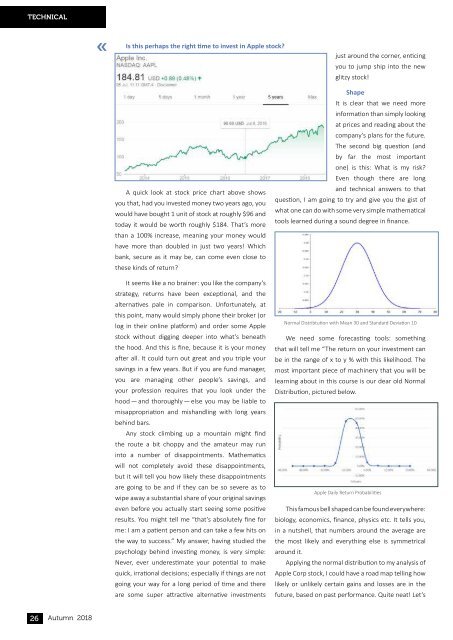THE ACCOUNTANT_AUTUMN_2018_VER-7-L
You also want an ePaper? Increase the reach of your titles
YUMPU automatically turns print PDFs into web optimized ePapers that Google loves.
TECHNICAL<br />
Is this perhaps the right time to invest in Apple stock?<br />
just around the corner, enticing<br />
you to jump ship into the new<br />
glitzy stock!<br />
A quick look at stock price chart above shows<br />
you that, had you invested money two years ago, you<br />
would have bought 1 unit of stock at roughly $96 and<br />
today it would be worth roughly $184. That’s more<br />
than a 100% increase, meaning your money would<br />
have more than doubled in just two years! Which<br />
bank, secure as it may be, can come even close to<br />
these kinds of return?<br />
It seems like a no brainer: you like the company’s<br />
strategy, returns have been exceptional, and the<br />
alternatives pale in comparison. Unfortunately, at<br />
this point, many would simply phone their broker (or<br />
log in their online platform) and order some Apple<br />
stock without digging deeper into what’s beneath<br />
the hood. And this is fine, because it is your money<br />
after all. It could turn out great and you triple your<br />
savings in a few years. But if you are fund manager,<br />
you are managing other people’s savings, and<br />
your profession requires that you look under the<br />
hood — and thoroughly — else you may be liable to<br />
misappropriation and mishandling with long years<br />
behind bars.<br />
Any stock climbing up a mountain might find<br />
the route a bit choppy and the amateur may run<br />
into a number of disappointments. Mathematics<br />
will not completely avoid these disappointments,<br />
but it will tell you how likely these disappointments<br />
are going to be and if they can be so severe as to<br />
wipe away a substantial share of your original savings<br />
even before you actually start seeing some positive<br />
results. You might tell me “that’s absolutely fine for<br />
me: I am a patient person and can take a few hits on<br />
the way to success.” My answer, having studied the<br />
psychology behind investing money, is very simple:<br />
Never, ever underestimate your potential to make<br />
quick, irrational decisions; especially if things are not<br />
going your way for a long period of time and there<br />
are some super attractive alternative investments<br />
Shape<br />
It is clear that we need more<br />
information than simply looking<br />
at prices and reading about the<br />
company’s plans for the future.<br />
The second big question (and<br />
by far the most important<br />
one) is this: What is my risk?<br />
Even though there are long<br />
and technical answers to that<br />
question, I am going to try and give you the gist of<br />
what one can do with some very simple mathematical<br />
tools learned during a sound degree in finance.<br />
Normal Distribtution with Mean 30 and Standard Deviation 10<br />
We need some forecasting tools: something<br />
that will tell me “The return on your investment can<br />
be in the range of x to y % with this likelihood. The<br />
most important piece of machinery that you will be<br />
learning about in this course is our dear old Normal<br />
Distribution, pictured below.<br />
Apple Daily Return Probabilities<br />
This famous bell shaped can be found everywhere:<br />
biology, economics, finance, physics etc. It tells you,<br />
in a nutshell, that numbers around the average are<br />
the most likely and everything else is symmetrical<br />
around it.<br />
Applying the normal distribution to my analysis of<br />
Apple Corp stock, I could have a road map telling how<br />
likely or unlikely certain gains and losses are in the<br />
future, based on past performance. Quite neat! Let’s<br />
26 Autumn <strong>2018</strong>
















